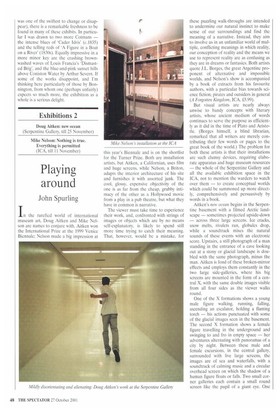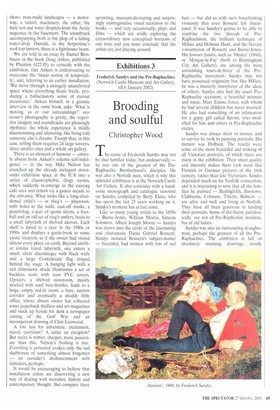Exhibitions 2
Doug Aitken: new ocean (Serpentine Gallery, till 25 November) Mike Nelson: Nothing is true. Everything is permitted (ICA, till 11 November)
Playing around
John Spurling
In the rarefied world of international museum art, Doug Aitken and Mike Nelson are names to conjure with. Aitken won the International Prize at the 1999 Venice Biennale; Nelson made a big impression at
this year's Biennale and is on the shortlist for the Turner Prize. Both are installation artists, but Aitken, a Californian, uses film and huge screens, while Nelson, a Briton, adapts the interior architecture of his site and furnishes it with assorted junk. The cool, glossy, expensive objectivity of the one is as far from the cheap, grubby intimacy of the other as a Hollywood movie from a play in a pub theatre, but what they have in common is narrative.
The viewer must take time to experience their work, and, confronted with strings of images or objects which are by no means self-explanatory, is likely to spend still more time trying to catch their meaning. That, however, would be a mistake, for
these puzzling walk-throughs are intended to undermine our natural instinct to make sense of our surroundings and find the meaning of a narrative. Instead, they aim to involve us in an unfamiliar world of multiple, conflicting meanings in which reality, our conception of reality and the means we use to represent reality are as confusing as they are in dreams or fantasies. Both artists quote J.L. Borges, the great Argentine proponent of alternative and impossible worlds, and Nelson's show is accompanied by a book of extracts from his favourite authors, with a particular bias towards science fiction, pirates and outsiders in general (A Forgotten Kingdom, ICA, £5.99).
But visual artists are nearly always unwise to bandy concepts with literary artists, whose ancient medium of words continues to serve the purpose as efficiently as it did in the time of Plato and Aristotle. (Borges himself, a blind librarian, remarked that all writers are merely contributing their few words or pages to the great book of the world.) The problem for both these artists is that their installations are such clumsy devices, requiring elaborate apparatus and huge museum resources — the whole of the Serpentine Gallery and all the available exhibition space in the ICA, not to mention the warders to watch over them — to create conceptual worlds which could be summoned up more directly, comprehensively and persuasively by words in a book.
Aitken's new ocean begins in the Serpentine basement with a filmed Arctic landscape — sometimes projected upside-down
— across three large screens. Ice cracks, snow melts, rivulets run, globules drop, while a soundtrack mixes the natural sounds of these events with an electronic score. Upstairs, a still photograph of a man standing in the entrance of a cave looking out at a stony or glacial landscape is doubled with the same photograph, minus the man. Aitken is fond of these broken-mirror effects and employs them constantly in the two large side-galleries, where his big screens are mounted in the form of a central X, with the same double images visible from all four sides as the viewer walks round.
One of the X formations shows a young male figure walking, running, falling, ascending an escalator, holding a flaming torch — his actions punctuated with some of the glacial images seen in the basement. The second X formation shows a female figure travelling in the underground and swinging to and fro in empty space — her adventures alternating with panoramas of a city by night. Between these male and female excursions, in the central gallery, surrounded with live large screens, the images are of sea and waterfalls, with a soundtrack of calming music and a circular overhead screen on which the shadow of a human figure floats or falls. Two small corner galleries each contain a small round screen like the pupil of a giant eye. One shows man-made landscapes — a motorway, a tunnel. machinery; the other, the hazy sun and water droplets from the Arctic sequence in the basement. The soundtrack accompanying both is the plop of a falling water-drop. Outside, in the Serpentine's roof-top lantern, there is a lighthouse beam.
We are told in an essay by Daniel Birnbaum in the book Doug Aitken, published by Phaidon (£22.95) to coincide with the exhibition, that Aitken is endeavouring to overcome the 'linear notion of temporality', and, referring to an earlier installation, 'We move through a strangely unanchored space where everything floats freely, producing a hallucinatory sense of eternal recurrence.' Aitken himself, in a gnomic interview in the same book, asks: 'What is moving, us or our surroundings?' new ocean's photography is pretty, the repetitive imagery and soundtracks are pleasingly rhythmic; the whole experience is mildly disorientating and alienating, like being told someone else's dreams. Except that, in this case, telling them requires 24 large screens. three smaller ones and a whole art gallery.
There is an element of humour — entirely absent from Aitken's solemn self-indulgence — in the way Mike Nelson has crunched up the already inelegant downstairs exhibition space at the ICA into a series of claustrophobic, dingy rooms, which suddenly re-emerge in the existing café area and return via a games arcade to the entrance. What looks like a long-abandoned child's — or thug's — playroom, with holes in the walls, cast-off masks, a punch-bag, a pair of sports shorts, a football and an old set of stag's antlers, leads to a small labyrinth of shelved alcoves. Each shelf is dated to a year in the 1980s or 1990s and displays a guide-book to some exotic location, as if the owner had visited almost every place on earth. Beyond another similar travel labyrinth, one enters a small, silent discotheque with black walls and a large Confederate flag draped behind the stage. A hanging light with a red chinoiserie shade illuminates a set of backless seats with torn PVC covers. Upstairs, a shelved storeroom, mainly stocked with used beer-bottles, leads to a large, empty red-lit room, a bare, narrow corridor and eventually a shoddy little office, whose absent owner has collected some paperback thrillers and art magazines and stuck up beside his desk a newspaper cutting of the Gulf War and an incompetent drawing of Clint Eastwood.
A lost lust for adventure, excitement, travel, exoticism? A satire on escapism? But satire is wittier, sharper, more passionate than this. Nelson's Nothing is true. Everything is permitted evokes only the sad shabbiness of something almost forgotten — an outsider's disillusionment with outsiders, perhaps.
It would be encouraging to believe that installation artists are discovering a new way of dealing with narrative, history and contemporary thought. But compare these sprawling, museum-devouring and surprisingly unimaginative visual scenarios to the books — and very occasionally, plays and films — which are avidly exploring the extraordinary new conceptual horizons of our time and you must conclude that the artists are just playing around.











































































 Previous page
Previous page